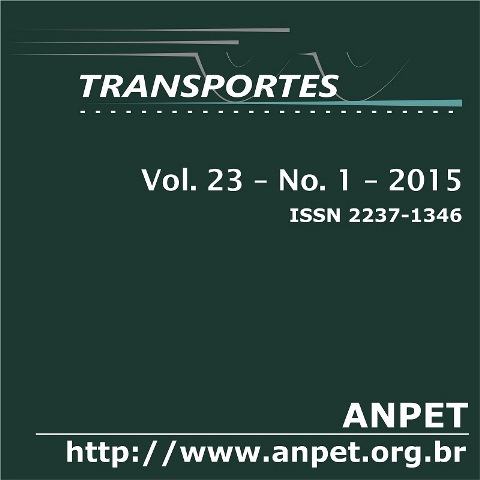Cross-Docking em centros logísticos de distribuição urbana: considerações sobre operação e modelagem
DOI:
https://doi.org/10.14295/transportes.v23i1.795Keywords:
urban logistics, queuing models, cross-docking, terminal dimensioning.Abstract
Urban Distribution Centres (UDCs) are terminals where goods, that are transported within a city’s central core district, are carried by small size vehicles with sustainable characteristics. Such terminals are usually operated in the cross-docking pattern, where the products are transferred from larger trucks to local distribution vehicles, and vice-versa. In this paper, a technical discussion is performed on the way such UDCs could be dimensioned, considering not only their internal parts, but the unloading/loading docks and the outdoor parking lot for trucks as well. The proposed methodology comprises non-traditional queuing models, whose calibration requires numerical approximation methods.Downloads
References
Agustina, D.; C.K.M. Lee e R. Piplani (2010). A review: Math-ematical Models for Cross Docking Planning. International Journal of Engineering Business Management, v. 2 n. 2, p. 47-54. DOI: 10.5772/9717
Anand, N.; Yang, M.; van Duin, J.H. e L. Tavasszy (2012). GenCLOn: An Ontology of City Logistics. Expert Systems with Applications, v. 39, p. 11944-11960. DOI: 10.1016/j.eswa.2012.03.
Antún, J.P. (2013). Distribución Urbana de Mercancías: Estra-tegias com Centros Logísticos. Nota Técnica # IDB-TN-167, BID – Banco Interamericano de Desarrollo.
Arnaout, G.; E. Rodriguez-Velasquez; G. Rabadi e R. Musa (2010). Modeling Cross-Docking Operations Using Discrete Event Simulation. EOMAS’10 Proceedings of the 6th International Workshop on Enterprise & Organizational Modeling and Simulation, p. 113-120, Aachen, Alemanha.
Bartholdi III, J. e K.R. Gue (2000). Reducing Labor Costs in an LTL Crossdocking Terminal. Operations Research, v. 48, p. 823-832. DOI: 10.1287/opre.48.6.823.12397
Bartholdi III, e K.R. Gue (2004). The Best Shape for a Crossdock. Transportation Science, v. 38, n. 2, p. 235-244. DOI: 10.1287/
trsc.1030.0077
Bartholdi III, J.; K.R. Gue e K. Kang (2008). Staging Protocols for Unit-Load Crossdocking. In: Lahmar, M., Facility Logistics, Auerbach Publications, New York, NY, p. 153-171.
Biderman, C. (2001). Forças de Atração e Expulsão na Grande São Paulo, Tese de Doutorado, EAESP, Fundação Getúlio Var-gas, São Paulo, SP.
Boudouin, D. (2012). Methodological Guide: Urban Logistics Spaces, CRET-LOG, Aix-Marseille, France.
Boysen, N. (2010). Truck scheduling at zero-inventory cross docking terminals. Computers & Operations Research, V. 37, pp. 32-41. DOI: 10.1016/j.cor.2009.03.010
Boysen, N. e M. Fliedner (2010). Cross Dock Scheduling: Literature Review and Research Agenda. Omega, v. 38, p. 413-422. DOI: 10.1016/j.omega.2009.10.008
Conway, R.W. e W.L. Maxwell (1962). A Queuing Model with State Dependent Service Rates. Journal of Industrial Engineering, v. 12, p. 132-136.
Crainic, T.G.; N. Ricciardi e G. Storchi (2009). Models for Evaluating and Planning City Logistics Systems. Publication nº 2009-11, CIRRELT, Montreal, Canadá.
Dablanc, L. (2009). Freight Transport: A Key for the New Urban Economy. The World Bank, Freight Transport for Development: A Policy Toolkit, July, 52 pgs.
Falconer, P. e P. Drury (1978). Almacenaje Industrial: Proyectos y Constructión para Almacenaje, H. Blume, Madrid.
Fogliatti, M.C. e N.M.C Mattos (2007). Teoria de Filas. Editora Interciência, Rio de Janeiro, RJ.
Gue, K.R. e K. Kang (2001). Staging Queues in Material Han-dling and Transportation Systems. Proceedings of the 2001 Winter Simulation Conference, Arlington, VA, EUA.
Larsen, A., 2001. The Dynamic Vehicle Routing Problem. PhD Dissertation, Technical University of Denmark. Lyngby, Den-mark. DOI: 10.1109/WSC.2001.977421
Mulcahy, D. (1994). Warehouse Distribution & Operations Handbook. McGraw-Hill, New York, NY.
Newell, G.F. (1971). Applications of Queueing Theory, Chapman and Hall, London, UK.
Novaes, A.G. (1975). Pesquisa Operacional e Transportes: Modelos Probabilísticos. Editora McG aw-Hill do Brasil, São Paulo.
Novaes, A.G.; Silva, V.M.D. e H. Rosa (2009). Utilização de Modelos de Filas e de Simulação no Planejamento de Terminais Marítimos de Contêineres, Anais do XXIII Anpet - Congresso Nacional de Ensino e Pesquisa em Transportes, Vitória, ES, Novembro 2009.
Odoni, A.R. e R. De Neufville (1992). Passenger Terminal Design. Transportation Research A, v. 1, p. 27-35. DOI: 10.1016/0965-8564(92)90042-6
Page, E. (1972). Queueing Theory in OR. Butterworths, Londres.
Patier, D. e F. Toilier (2012). Logistique Urbaine: Etat de l’Art en France et en Europe, Laboratoire d’Economie des Transports, < http://tmv.let.fr/documents/rapports/ Berlin2012.pdf >.
Quispel, M. (2002). Active Partnerships: The Key to Sustainable Urban Freight Transport. European Conference on Mobility Management, Gent, Bélgica, 15 a 17 Maio.
Saaty, T.L. (1961). Elements of Queueing Theory, With Applica-tions. McGraw-Hill, New York, NY.
Soltani, R. e S.J. Sadjadi (2010). Scheduling Trucks in Cross-Docking Systems: A Robust Meta-Heuristics Approach. Trans-portation Research Part E, v. 46, p. 650-666. DOI: 10.1016/j.tre.2009.12.011
Taniguchi, E.; M. Noritake; T. Yamada e T. Izumitani (1999). Optimal Size and Location Planning of Public Logistics Termi-nals. Transportation Research Part E, v. 35, p. 207-222. DOI: 10.1016/S1366-5545(99)00009-5
Taniguchi, E.; R.G. Thompson; T. Yamada e R. van Duin (2001). City Logistics: Network Modelling and Intelligent Transport Systems, Elsevier Science, Oxford, UK.
Trentini, A.; Feliu, J.G. e N. Malhéné (2013). Développement des Espaces Logistiques Urbains: CDU et ELP dans l’Europe du Sud-Ouest, <www.rechercheisidore.fr/search/resource/?uri=106
/1.xr5kk2>.
Vahdani, B. e M. Zandieh (2010) Scheduling Trucks in Cross-Docking Systems: Robust Meta-Heuristics. Computers & Indus-trial Engineering, v. 58, p. 12-24. DOi: 10.1016/j.cie.2009.06.006
Van Belle, J.; P. Valckenaers e D. Cattrysse (2012). Cross-Docking: State of the Art. Omega, v. 40, p. 827-846. DOI: 10.1016/j.omega.2012.01.005
Vis, I.F.A. e K.J. Roodbergen (2008). Positioning of Goods in a Cross-Docking Environment. Computers & Industrial Engineer-ing, v.54, p. 677-689. DOI: 10.1016/j.cie.2007.10.004
Downloads
Published
How to Cite
Issue
Section
License
Authors who submit papers for publication by TRANSPORTES agree to the following terms:
- The authors retain the copyright and grant Transportes the right of first publication of the manuscript, without any financial charge, and waive any other remuneration for its publication by ANPET.
- Upon publication by Transportes, the manuscript is automatically licensed under the Creative Commons License CC BY 4.0 license. This license permits the work to be shared with proper attribution to the authors and its original publication in this journal, and to be adapted for non-commercial purposes, provided appropriate credit is given and any derivative works are distributed under the same terms.
- Authors are authorized to enter into additional separate contracts for the non-exclusive distribution of the version of the manuscript published in this journal (e.g., publishing in an institutional repository or as a book chapter), with recognition of the initial publication in this journal, provided that such a contract does not imply an endorsement of the content of the manuscript or the new medium by ANPET.
- Authors are permitted and encouraged to publish and distribute their work online (e.g., in institutional repositories or on their personal websites) after the editorial process is complete. As Transportes provides open access to all published issues, authors are encouraged to use links to the DOI of their article in these cases.
- Authors guarantee that they have obtained the necessary authorization from their employers for the transfer of rights under this agreement, if these employers hold any copyright over the manuscript. Additionally, authors assume all responsibility for any copyright infringements by these employers, releasing ANPET and Transportes from any responsibility in this regard.
- Authors assume full responsibility for the content of the manuscript, including the necessary and appropriate authorizations for the disclosure of collected data and obtained results, releasing ANPET and Transportes from any responsibility in this regard.









